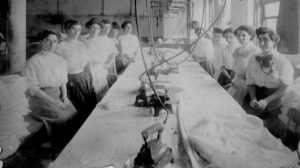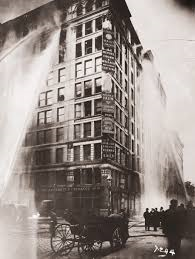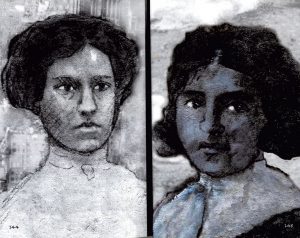 Fire safety measures have vastly improved over the years, but in the early 1900s, no such safety measures existed. That would prove deadly on March 25, 1911 in New York City. People didn’t really know about materials that were more flammable, other than wood. Nevertheless, wood was the main material used in buildings, and in fact, still is today. The Triangle Shirtwaist Company factory was owned by Max Blanck and Isaac Harris. It was located in the top three floors of the Asch Building, on the corner of Greene Street and Washington Place, in Manhattan. These days that is not really a place we would expect to see a factory…much less a sweatshop, but the Triangle Shirtwaist Company’s factory was a true sweatshop. They employed mostly young immigrant women who worked in a cramped space at lines of sewing machines. Nearly all the workers were teenaged girls who did not speak English and made only about $15 per week working 12 hours a day, every day.
Fire safety measures have vastly improved over the years, but in the early 1900s, no such safety measures existed. That would prove deadly on March 25, 1911 in New York City. People didn’t really know about materials that were more flammable, other than wood. Nevertheless, wood was the main material used in buildings, and in fact, still is today. The Triangle Shirtwaist Company factory was owned by Max Blanck and Isaac Harris. It was located in the top three floors of the Asch Building, on the corner of Greene Street and Washington Place, in Manhattan. These days that is not really a place we would expect to see a factory…much less a sweatshop, but the Triangle Shirtwaist Company’s factory was a true sweatshop. They employed mostly young immigrant women who worked in a cramped space at lines of sewing machines. Nearly all the workers were teenaged girls who did not speak English and made only about $15 per week working 12 hours a day, every day.
In 1911, the Asch Building had four elevators with access to the factory floors, but only one was fully operational and the workers had to file down a long, narrow corridor in order to reach it. There were also two stairways down to the street, but one was locked from the outside to prevent stealing and the door of the other only opened inward. The fire escape was so narrow that it would have taken hours for all the workers to use it, even in the best of circumstances…in an emergency, it was almost useless. Pretty much everyone knew about the danger of fire in factories like the Triangle Shirtwaist Company factory, but high levels of corruption in both the garment industry and city government ensured that no useful precautions were taken to prevent fires. The  problem was that making the factories safe cost money, and dug into the profits, so the owners didn’t want to do what was necessary to save lives. The Triangle Shirtwaist Company factory’s owners were known to be particularly anti-worker in their policies and had played a critical role in breaking a large strike by workers the previous year.
problem was that making the factories safe cost money, and dug into the profits, so the owners didn’t want to do what was necessary to save lives. The Triangle Shirtwaist Company factory’s owners were known to be particularly anti-worker in their policies and had played a critical role in breaking a large strike by workers the previous year.
On March 25, a Saturday afternoon, there were 600 workers at the factory when a fire began in a rag bin. The manager attempted to use the fire hose to extinguish it, but was unsuccessful. The hose was rotted and its valve was rusted shut. They were at the mercy of the raging inferno. The fire grew and the workers panicked. They tried to exit the building by the elevator, but it could only hold 12 people and the operator was able to make just four trips before it broke down due to the heat and flames. In a desperate attempt to escape the flames. The girls left behind waiting for the elevator plunged down the shaft to their deaths. The girls who fled by way of the stairwells also met awful fates. When they found a locked door at the bottom of the stairs, many were burned alive. In all, 145 workers between the ages of 14 and 43, mostly women and mostly in their teens and early twenties, died that day. Six of them would not be identified until February, 2011…100 years later.
Once the fire was reported, the firefighters tried to put it out, but their ladders would only reach the seventh floor. The fire was on the eighth floor. When escape was proven to be impossible, the girls, desperate to escape the searing heat and flames, began to jump. The bodies of those who jumped landed on the hoses, hampering the flow. The firemen got out nets to catch the girls, but they jumped three at a time, tearing the nets. The nets were of no real help. Within 18 minutes, it was all over. Of the dead, 49 workers had burned to death or been suffocated by smoke, 36 were dead in the elevator shaft and 58 died from jumping to the sidewalks. Two  more died later from their injuries. The workers’ union set up a march on April 5 on New York’s Fifth Avenue to protest the conditions that had led to the fire. It was attended by 80,000 outraged people. Despite a good deal of evidence that the owners and management had been horribly negligent in the fire, a grand jury failed to indict them on manslaughter charges. The tragedy did result in some good, however. The International Ladies Garment Workers Union was formed in the aftermath of the fire and the Sullivan-Hoey Fire Prevention Law was passed in New York that October. Both were crucial in preventing similar disasters in the future. Still, I think that it will take the memory of the victims of corruption to ever really inspire people to change the way things are.
more died later from their injuries. The workers’ union set up a march on April 5 on New York’s Fifth Avenue to protest the conditions that had led to the fire. It was attended by 80,000 outraged people. Despite a good deal of evidence that the owners and management had been horribly negligent in the fire, a grand jury failed to indict them on manslaughter charges. The tragedy did result in some good, however. The International Ladies Garment Workers Union was formed in the aftermath of the fire and the Sullivan-Hoey Fire Prevention Law was passed in New York that October. Both were crucial in preventing similar disasters in the future. Still, I think that it will take the memory of the victims of corruption to ever really inspire people to change the way things are.


Leave a Reply